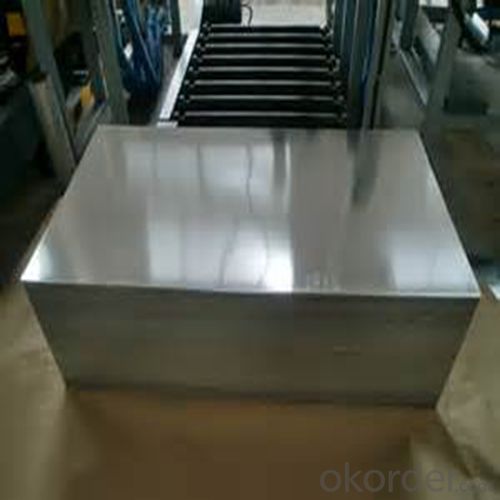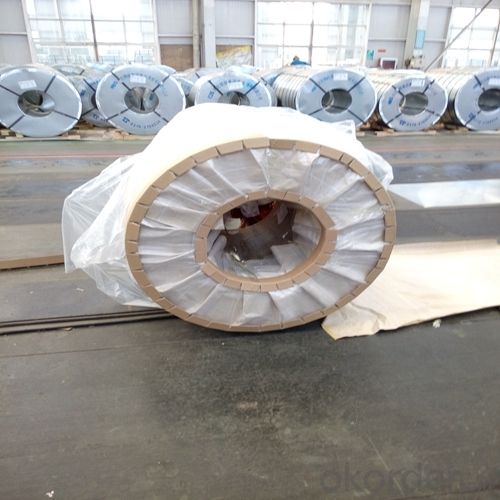Tin Free Steel of Prime Quality for Metal Caps
- Loading Port:
- Shanghai
- Payment Terms:
- TT OR LC
- Min Order Qty:
- 25 m.t.
- Supply Capability:
- 25000 m.t./month
OKorder Service Pledge
OKorder Financial Service
You Might Also Like
Item specifice
1.Structure of Tin Free Steel of Prime Quality for Metal Caps Description
Tin Free Steel (TFS) is thin black plate with two coats; one of metal chrome film and the other of chromium oxide. TFS is ideal for the manufacturing of crowns, container ends & shallow drawn cans etc. TFS is also known as Chromium coated steel.
2.Main Features of the Tin Free Steel of Prime Quality for Metal Caps
Chromium coated
Easier to recycle.
Sulphur Blackening Resistance: TFS has sulphur resistance properties, which can be used for canning protein- rich food such as fish.
Filiform Rust Resistance: Filiform is superficial corrosion of the base metal. TFS has a superior base metal which makes it corrosion resistance.
Coating: The coating in TFS is not amphoteric (having the characteristic of an acid and a base, is a compound that can react as either an acid or a base). This means that detergents and dispersion colors can be packed easily.
3.Tin Free Steel of Prime Quality for Metal Caps Images


4.Tin Free Steel of Prime Quality for Metal Caps Specification
Our materials are from big mills.
The surface and the edge are glossy
It is export package
5.FAQ of Tin Free Steel of Prime Quality for Metal Caps
-What is MOQ?
Our MOQ would be 25 tons.
- Do you only have prime quality TFS ?
We can supply both prime and second quality TFS.
- Q:What are the advantages of using tinplate for aerosol cans?
- Some advantages of using tinplate for aerosol cans include its durability, corrosion resistance, and ability to maintain product quality. Tinplate cans offer a longer shelf life for aerosol products as they prevent air and moisture from entering the can, ensuring the product remains fresh and effective. Additionally, tinplate cans are lightweight, making them convenient for transportation and storage. They are also recyclable, contributing to sustainability efforts.
- Q:How is tinplate coated with organic coatings?
- Tinplate is coated with organic coatings through a process called coil coating. In this process, the tinplate is cleaned and pre-treated to ensure proper adhesion of the coating. Then, a thin layer of organic coating is applied onto the surface of the tinplate using various methods such as roller coating or spraying. The coated tinplate is then cured at high temperatures to ensure the coating adheres firmly. This organic coating provides protection against corrosion and enhances the appearance of the tinplate.
- Q:Can tinplate be used for furniture?
- Yes, tinplate can be used for certain types of furniture, particularly for creating decorative elements or accents. However, it is not commonly used as the primary material for furniture due to its relatively low strength and durability compared to other metals like steel or aluminum.
- Q:Can tinplate be painted or printed on?
- Yes, tinplate can be painted or printed on.
- Q:What are the different types of tinplate finishes available?
- Some of the different types of tinplate finishes available include bright, matte, and stone finishes.
- Q:How does tinplate maintain its shape during the manufacturing process?
- Tinplate maintains its shape during the manufacturing process due to its inherent strength and rigidity, which is achieved through a combination of factors. Firstly, the steel substrate used in tinplate is typically made from low-carbon steel, which provides a sturdy foundation. Additionally, the tin coating on the steel provides an added layer of protection and stability. The tin layer acts as a barrier against corrosion and helps to prevent deformation or warping of the tinplate. Moreover, the manufacturing process involves carefully controlling the temperature and pressure, ensuring that the tinplate retains its shape and structural integrity.
- Q:Can tinplate be used for packaging chemicals?
- Yes, tinplate can be used for packaging chemicals. It is a commonly used material for packaging due to its durability, resistance to corrosion, and ability to protect against light and oxygen. Tinplate is also known for its ability to withstand various temperatures and pressures, making it suitable for storing and transporting a wide range of chemicals safely.
- Q:What are the main safety regulations for tinplate production and use?
- The main safety regulations for tinplate production and use include ensuring proper ventilation and exhaust systems to prevent exposure to harmful fumes, implementing effective fire prevention and control measures, providing personal protective equipment for workers such as gloves and goggles, conducting regular maintenance and inspection of equipment to prevent accidents, and adhering to strict quality control standards to ensure the safety of the final product. Additionally, proper training and education about safety protocols should be provided to all employees to minimize risks and ensure a safe working environment.
- Q:How is tinplate recycled and what are its recycling rates?
- Tinplate is recycled through a process called "tinplate recycling" where it is collected, sorted, and melted down to create new products. The recycling rates of tinplate vary depending on factors such as regional recycling infrastructure, collection efforts, and consumer awareness. However, on average, tinplate has a relatively high recycling rate of around 80-90% in many developed countries.
- Q:How does tinplate contribute to the shelf life of canned products?
- Tinplate contributes to the shelf life of canned products by providing a protective barrier that prevents contact between the food and the metal of the can. This barrier helps to minimize the risk of corrosion and preserves the quality, flavor, and nutritional value of the canned product for an extended period of time.
1. Manufacturer Overview |
|
|---|---|
| Location | |
| Year Established | |
| Annual Output Value | |
| Main Markets | |
| Company Certifications | |
2. Manufacturer Certificates |
|
|---|---|
| a) Certification Name | |
| Range | |
| Reference | |
| Validity Period | |
3. Manufacturer Capability |
|
|---|---|
| a)Trade Capacity | |
| Nearest Port | |
| Export Percentage | |
| No.of Employees in Trade Department | |
| Language Spoken: | |
| b)Factory Information | |
| Factory Size: | |
| No. of Production Lines | |
| Contract Manufacturing | |
| Product Price Range | |
Send your message to us
Tin Free Steel of Prime Quality for Metal Caps
- Loading Port:
- Shanghai
- Payment Terms:
- TT OR LC
- Min Order Qty:
- 25 m.t.
- Supply Capability:
- 25000 m.t./month
OKorder Service Pledge
OKorder Financial Service
Similar products
New products
Hot products
Related keywords




























